Author's posts
Aug 13 2012
Sunday Train: zOMG these aint REAL HSR trains!
Burning the Midnight Oil for Living Energy Independence
crossposted from Voices on the Square
 This is more or less the three year anniversary of the first Sunday Train ~ a bit less than more, since this is the 12th of August 2012 and I think that the first Sunday Train was 16th of August, 2009. It emerged from a variety of blogging I had been doing over the previous couple of years, with a notion that if I set down a target of blogging on Sunday, it would make it easier for people to track the Sunday Train down. It was originally posted at my midnight-populist blogspot, Burning the Midnight Oil, crossposted to Agent Orange, My Left Wing, Progressive Blue and Docudharma, but I was never really enthusiastic about building up my own blog, and nor about the constraints of blogspot, so over time I settled on writing the Sunday Train at a community blog, cross-posting it to other community blogs, and posting the summary to Burning the Midnight Oil, with cross-links to the blogs containing that week’s full post.
This is more or less the three year anniversary of the first Sunday Train ~ a bit less than more, since this is the 12th of August 2012 and I think that the first Sunday Train was 16th of August, 2009. It emerged from a variety of blogging I had been doing over the previous couple of years, with a notion that if I set down a target of blogging on Sunday, it would make it easier for people to track the Sunday Train down. It was originally posted at my midnight-populist blogspot, Burning the Midnight Oil, crossposted to Agent Orange, My Left Wing, Progressive Blue and Docudharma, but I was never really enthusiastic about building up my own blog, and nor about the constraints of blogspot, so over time I settled on writing the Sunday Train at a community blog, cross-posting it to other community blogs, and posting the summary to Burning the Midnight Oil, with cross-links to the blogs containing that week’s full post.
The crosspost list also varied from time to time: of those original community blogs, I rarely visit My Left Wing or Docudharma much anymore, and the best of Progressive Blue has been folded into the broader coalition at Voices on the Square, which since its launch last month has been the new home base for Sunday Train. The Sunday Train still rolls into Agent Orange (aka “daily kos”), and has for some time also stopped at Hillbilly Report and the Stars Hollow Gazette, and occasionally at the European Tribune.
In celebration of the three year anniversary, more or less, I am reprinting the diary from the 16th August, 2009, “zOMG, these aint REAL HSR trains!”
Aug 06 2012
Sunday Train: Cycle & Pedestrian Islands and Tiny Trains
Burning the Midnight Oil for Living Energy Independence
crossposted from Voices on the Square
 “Oh, sure, more than 1/5 of journeys to work in Eindhoven, The Hague, Amsterdam and Utrecht in the Netherlands are by bike, but they are flat. It would never work here, its hilly.” Given that Copenhagen has one of the highest European cycling mode shares in trips to work, winter is obviously not the obstacle that it is sometimes made out to be ~ ah, but hills. They are an insuperable obstacle.
“Oh, sure, more than 1/5 of journeys to work in Eindhoven, The Hague, Amsterdam and Utrecht in the Netherlands are by bike, but they are flat. It would never work here, its hilly.” Given that Copenhagen has one of the highest European cycling mode shares in trips to work, winter is obviously not the obstacle that it is sometimes made out to be ~ ah, but hills. They are an insuperable obstacle.
Back in April, 2010, comparing Portland and Seattle, Jarret Walker asked, Should we plan transit for “bikeability”? This was following a project by Adam Parast comparing the cycling potential of Portland and Seattle, including potential bikeability with improved infrastructure. And the geography of Portland, with most development and activity on the flat or gently sloping floor of a valley, is substantially different from the geography of Seattle, built on “seven hills”, with water obstacles tossed in for good measure.
Today’s Sunday Train looks at what role public transport can serve in helping to increase cycling mode share.
Jul 30 2012
Sunday Train: Rescuing the Exurb from its Design
Burning the Midnight Oil for Living Energy Independence
crossposted from Voices on the Square
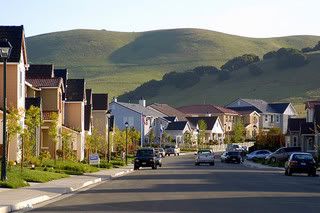 Back in April, Hope Yen was on the Huffington Post with Sprawling Suburbs Growth Falls To Historic Low Amid High Gas Prices
Back in April, Hope Yen was on the Huffington Post with Sprawling Suburbs Growth Falls To Historic Low Amid High Gas Prices
All across the U.S., residential exurbs that sprouted on the edge of metropolitan areas are seeing their growth fizzle, according to new 2011 census estimates released Thursday.
…
“The heyday of exurbs may well be behind us,” Yale University economist Robert J. Shiller said. Shiller, co-creator of a Standard & Poor’s housing index, is perhaps best known for identifying the risks of a U.S. housing bubble before it actually burst in 2006-2007. Examining the current market, he believes America is now at a turning point, shifting away from faraway suburbs to cities amid persistently high gasoline prices.
…
“Suburban housing prices may not recover in our lifetime,” Shiller said, calling the development of suburbs since 1950 “unusual,” enabled only by the rise of the automobile and the nation’s highway system.
As it was originally designed, Outer Suburbia and Exurbia was designed to fail in an era where increasing energy efficiency will be a fundamental platform for ongoing growth. However, its possible to retrofit Outer Suburbia and Exurbia to a more sustainable design.
Jul 23 2012
Sunday Train: Trains, Buses, Bikes and Plan C
Burning the Midnight Oil for Living Energy Independence
crossposted from Voices on the Square
 So, you’ve got Plan A. And in case something goes awry with Plan A, you’ve got your fallback plan, Plan B.
So, you’ve got Plan A. And in case something goes awry with Plan A, you’ve got your fallback plan, Plan B.
But what is the fit really hits the shan? What if all the assumptions that lie behind your planning turn out to be false. Things are far worse than ever contemplated in Plan A and Plan B? That’s when you turn to your Plan C, your Plan in case of Complete Catastrophe. In the event of a complete catastrophe, all of the polite fictions of the normal planning process go out the window. Which also means that Plan C is quite often the answer to, “Oh, now what do we do?, and the answer is, “Come up with something that will work ”
So, we have a crisis. A serious crisis, affecting our current transport system, which means a crisis that at the very least interferes with our supply of gasoline. But we have the Petroleum Reserve, so … assume its not a temporary emergency, but a crisis that threatens to last for years. Whether the Crisis hits next year or next decade, well, I don’t know that, do I? But suppose that its coming sometime in the next decade.
What would we face in coming up with something that will work?
Jul 16 2012
Sunday Train: NEC High Speed Rail for Under $20b
Burning the Midnight Oil for Living Energy Independence
crossposted from Voices on the Square
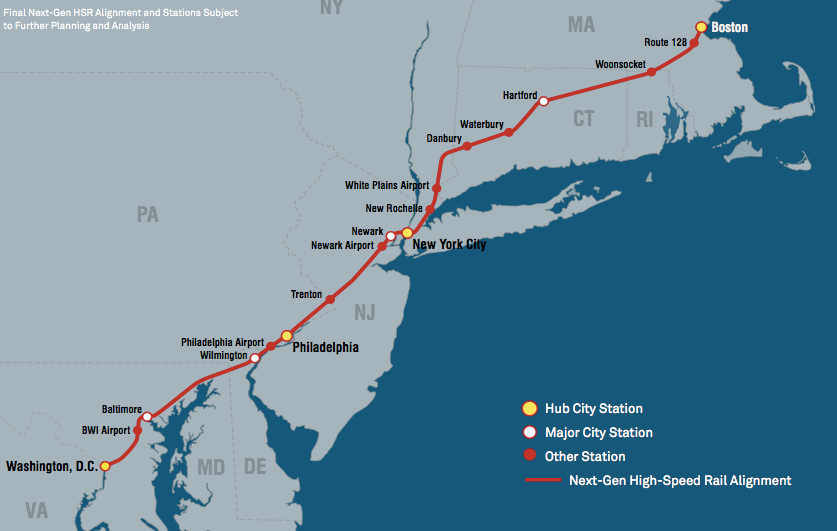 One of the transit bloggers that I enjoy reading is Alon Levy who blogs his observations on a variety of transit topics at Pedestrian Observations . Following the important California HSR funding vote in the California State Senate and the excitement leading up to it, I thought I’d like to take a look at the proposed Express HSR system for the states of the Northeast Corridor.
One of the transit bloggers that I enjoy reading is Alon Levy who blogs his observations on a variety of transit topics at Pedestrian Observations . Following the important California HSR funding vote in the California State Senate and the excitement leading up to it, I thought I’d like to take a look at the proposed Express HSR system for the states of the Northeast Corridor.
Of the $53b cost of the proposed San Francisco to Los Angeles Express HSR corridor seems hefty ~ and it seems even heftier when it shows the Year of Expenditure headline value of $68b ~ then the proposed Northeast Corridor states Express HSR will seem massive.
However, Alon claims:
Northeast Corridor HSR, 90% Cheaper
…
In contrast with this extravaganza, it is possible to achieve comparable travel times for about one tenth the cost. The important thing is to build the projects with the most benefit measured in travel time reduced or reliability gained per unit of cost, and also share tracks heavily with commuter rail, using timed overtakes to reduce the required amount of multi-tracking.
This sounds like an intriguing possibility … but is it realistic? Or is it wishful thinking? Follow me below the fold, and then let’s discuss it.
Jul 09 2012
Sunday Train: California Senate Approves High Speed Rail Construction
Burning the Midnight Oil for Living Energy Independence
Crossposted from its home station at Voices on the Square
Firedog Lake: California Legislature Passes High Speed Rail Bond Issue, Moving Project Forward ~ David Dayen
…
In a closely watched vote of the California state Senate, a bill to issue the first $5.8 billion in bonds for the construction of high speed rail lines passed 21-16. It needed all 21 votes to pass. Four Democrats voted no – including Allen Lowenthal, the Democratic candidate for Congress in CA-47, and Fran Pavley, the author of the state’s historic global warming law – but ultimately, just enough Democrats voted in favor of the bonds for them to pass. Joe Simitian and Mark DeSaulnier were the other Democrats who opposed the bill.
…
This does not end the battle for high speed rail. Between the bond issue and the federal money, that covers only about 1/5 of the total funding needed for the full project, which would connect Sacramento and San Diego and all points in between by high speed rail. But if this died today, you can be certain that nothing would ever get built. The federal government was prepared to take away the $3.2 billion in stimulus dollars earmarked for this stage of the project. And faith in the future of high speed rail in California – and indeed the nation – would have been sapped.
So … what now?
Jul 09 2012
Sunday Train: California Senate Approves High Speed Rail Construction
Burning the Midnight Oil for Living Energy Independence
Crossposted from its home station at Voices on the Square
Firedog Lake: California Legislature Passes High Speed Rail Bond Issue, Moving Project Forward ~ David Dayen
…
In a closely watched vote of the California state Senate, a bill to issue the first $5.8 billion in bonds for the construction of high speed rail lines passed 21-16. It needed all 21 votes to pass. Four Democrats voted no – including Allen Lowenthal, the Democratic candidate for Congress in CA-47, and Fran Pavley, the author of the state’s historic global warming law – but ultimately, just enough Democrats voted in favor of the bonds for them to pass. Joe Simitian and Mark DeSaulnier were the other Democrats who opposed the bill.
…
This does not end the battle for high speed rail. Between the bond issue and the federal money, that covers only about 1/5 of the total funding needed for the full project, which would connect Sacramento and San Diego and all points in between by high speed rail. But if this died today, you can be certain that nothing would ever get built. The federal government was prepared to take away the $3.2 billion in stimulus dollars earmarked for this stage of the project. And faith in the future of high speed rail in California – and indeed the nation – would have been sapped.
So … what now?
Jul 02 2012
Sunday Train: Is State Sen. Simitian aiming to kill High Speed Rail in California?
Burning the Midnight Oil for Living Energy Independence
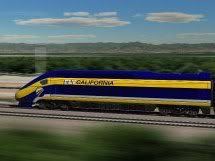 This coming week is supposed to contain an important symbolic Independence Day: the day when the California State Senate votes whether or not to proceed with one strategic element of Energy Independent Transport for the State of California, or whether to gamble the state’s future on petroleum.
This coming week is supposed to contain an important symbolic Independence Day: the day when the California State Senate votes whether or not to proceed with one strategic element of Energy Independent Transport for the State of California, or whether to gamble the state’s future on petroleum.
It is, of course, a very sure thing as a gamble ~ on the losing side. They aren’t making more, and the butane from natural gas liquids and energy inefficient production of ethanol from corn starch that has been used to juke the states on US “liquid fuel production” doesn’t change the fact that we still depend on petroleum imports for over half of our petroleum consumption. We deplete more and more low production cost petroleum every year, shifting our consumption to higher cost petroleum.
And even if we had the petroleum that Pollyannas would like to wish into existence, we can’t afford to burn it all at an accelerating rate, due to the CO2 emissions that will result.
State Senator Simitian does not seem to see it that way, as he appears set to vote kill the effort to allow the California High Speed Rail project to break ground next year.
Now, in an wonderful display of political pretzel logic, State Senator Simitian threatens to kill the HSR project will declaring his strong support of it: it will all be someone else’s fault if he votes to refuse to break ground next year.
Jun 25 2012
Sunday Train: Livable Tranport if the Future Differs from the Past
Burning the Midnight Oil for Living Energy Independence
 California is on a deadline from DC to either appropriate the funds to begin work on the first segment of the California HSR project, or else the Dept. of Transport will rescind California’s grant and hand the money over to other states.
California is on a deadline from DC to either appropriate the funds to begin work on the first segment of the California HSR project, or else the Dept. of Transport will rescind California’s grant and hand the money over to other states.
One of the key controversies is the fact that there is no guarantee that the funding required for building the complete system will be forthcoming. And so, the argument goes, if the first construction segment is built, but no additional Federal funding for HSR is ever again authorized and appropriated, California will be stuck with a White Elephant.
This is, indeed, the “risk” that the California Legislative Analyst Office (LAO) has focused on in its series of anti-HSR analyses.
The LAO’s analysis includes the presumption that the Federal funds already granted can simply be re-allocated by California to be spent in the way that the LAO advises, which is a quite bizarre fantasy to be set forward in what is supposed to be professional analysis at the California taxpayer’s expense. By including this fantasy in their analysis, they can evade the question of, “would we be better off doing nothing?”
Reality does not allow the question to be evaded. If we continue to do nothing on the argument that whatever step forward actually on offer is inferior to some fictitious imagined superior plan, we will in the end arrive in the future having done nothing, and will find out the hard way whether or not that was a wise decision to make.
Now, if the future is identical to the past, then a system that worked well enough in the past can work well enough in the future. However, if the future differs from the past ~ as history teaches us it always has before ~ then the systems that worked well enough in the past will be unsuited to the future.
What we need, “if” the Future differs from the Past, is the flexibility to adapt to changes. Both the changes we can see coming, and the changes that we cannot see coming.
Jun 18 2012
Sunday Train: The Steel Interstate and the Great Highway Lie
Burning the Midnight Oil for Living Energy Independence
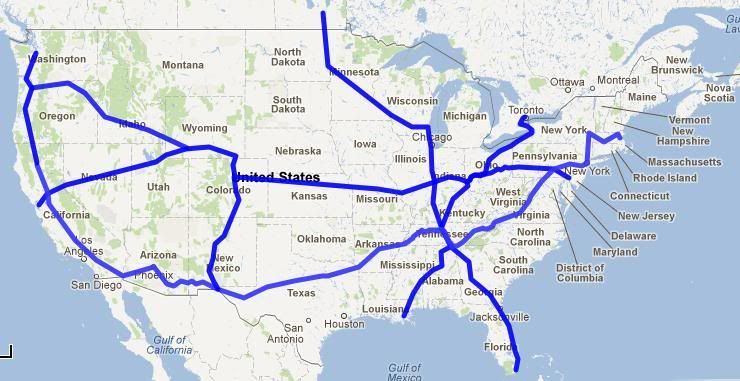 The last two weeks on the Sunday Train, I’ve been writing about the Steel Interstate. Steel Interstates & An America That Can Do Big Things (3 June) revisited the basic concept, and Putting Steel into the Amtrak Long Distance Backbone primarily discussed the first third of the Congressionally mandated reports on improving Amtrak’s long distance rail network, but also discussed a bit about the role of long distance trains in the context of the Steel Interstate proposal.
The last two weeks on the Sunday Train, I’ve been writing about the Steel Interstate. Steel Interstates & An America That Can Do Big Things (3 June) revisited the basic concept, and Putting Steel into the Amtrak Long Distance Backbone primarily discussed the first third of the Congressionally mandated reports on improving Amtrak’s long distance rail network, but also discussed a bit about the role of long distance trains in the context of the Steel Interstate proposal.
This week, the attention shifts from the Steel Interstate infrastructure to the substantial benefit to our existing legacy Asphalt Interstates if the United States elects to retain a viable national economy by implementing some form of Steel Interstate electric rapid freight rail system for long-haul freight.
Along the way, I spend a bit of time talking about misconceptions about the cost of our legacy system. Myth and misconception that are sufficiently widely help may be sufficient platform for gathering majority support for a system … but its not a sufficient platform for putting together a sustainable system, in either physical, ecological, economic, or financial senses of “sustainable”.

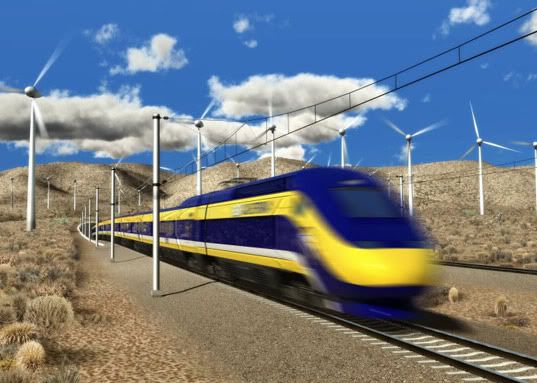
Recent Comments